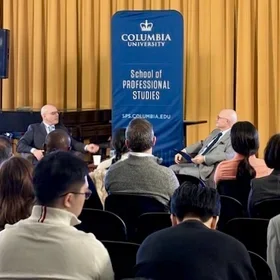Written by Meghaan Lurtz, Ph.D.
Meghaan Lurtz, Ph.D., is a lecturer in the M.P.S. in Wealth Management program at the Columbia University School of Professional Studies. She teaches Financial Psychology, which focuses on the intersection of human psychology and wealth management and the basic elements of consumer behavior. Students will explore all of the biases, behaviors, and perceptions that impact client decision-making and financial well-being. Dr. Lurtz coauthored two chapters in Financial Psychology, a book published by the Certified Financial Planner Board.
Dr. Lurtz is a writer and senior research associate with Kitces.com, a blog dedicated to the practice of financial planning. She has been quoted in New York magazine, The New York Times, and The Wall Street Journal. Dr. Lurtz earned her Ph.D. in personal financial planning from Kansas State University, her M.S. in industrial organizational psychology from Capella University, and her B.A. in psychology, philosophy, and Spanish from the University of Kansas.
Whether or not financial professionals realize it or like it, their job requires client conversations that cannot be solved with only a time-value-of-money calculation. According to research by David A. Dubofsky and Lyle Sussman, financial professionals are constantly having conversations about family relationships, conflict, values, and goals.
And there lies the rub—how do advisors solve nonfinancial issues? Is it even their job to solve nonfinancial issues? What do advisors do to solve these nonfinancial issues? And have financial advisors done their job if a nonfinancial issue persists? Is there a way for advisors to address nonfinancial issues while remaining in the practice of financial planning without venturing into mental health?
A common nonfinancial issue that finds its way into financial meetings is death. Financial professionals who work a lot with couples may watch a client lose a spouse or other family members. Often the financial advisor will be the first professional the client speaks with upon losing their loved one. The process for handling that meeting, the emotion, and all the financial stuff is far from simple.
It helps, to be sure, to have an estate plan to work with. The best plans keep everything running smoothly during a crisis. (Poor estate plans make an already difficult situation feel impossible.)
But there is so much more to deal with when it comes to grieving clients. So, emotionally, what is the role of the financial advisor? And what can or what does the financial advisor want to do to support clients?
The first thing to consider, the easier one, is the advisor’s comfort, capacity, and service model. What do advisors do—and what do advisors not do—in these moments? Does the advisor have the capacity and a service model that is set up to assist clients in a grieving transition? How will the advisor check in and keep tabs on a client in transition and support them in a way that is respectful to the rest of the client base and the advisor’s own life and time?
In order to answer that question, advisors will want to think about a meeting cadence and developing a service system that takes time, specifically time for transition. Advisors may want to meet with clients every three months, or six months, for a year or two, having the same meeting again and again, in order to keep tabs on the client and answer the client’s questions—but also create that space and time between the event and reaching a new place where the client wants to plan for the future. (For additional ideas on what that might look like, check out this article on rediscovery meetings for widowed clients.)
Now the more difficult question: Have advisors done their job if grief, stress, conflict, or anxiety continually shows up in the client-advisor relationship? Essentially, there seems to be an unspoken assumption that no grief, no stress, zero conflict, and no anxiety would be the best and only way to say or measure that a financial or nonfinancial issue has been resolved. Yet, this idealized situation is not only unlikely—in fact, it is possible that it might be what stops financial advisors and clients from growing together and moving forward.
Furthermore, another way to understand grief (and even other emotions like stress, anxiety, or shame that advisors might also run into) is the method of “hope and cope.” Hope and cope was developed by Pauline Boss, who—unlike Elisabeth Kubler Ross (famous for the five stages of grief model)—studied the bereaved as opposed to the dying. Hope and cope takes the approach that waiting for grief (or another emotion) to subside in order to go back to planning is not necessary and maybe not even realistic. Instead, we can hope that things get better—advisors and clients can hope they have less grief, stress, and anxiety, but (the bigger consideration) advisors and clients can also cope. They can cope during difficult moments, and they can cope during less difficult moments—the need for no difficulty, no stress, and no grief as a prerequisite for planning is gone.
This hope and cope method provides more opportunities and discussion points for advisors but also creates less shame and anxiety around grief and mental health more generally for clients. Essentially, people have stress that they have stress or grieve the fact that they are still grieving—believing that the only way to be better is to be without these negative emotions. This is not only incorrect, but it can also be debilitating. If clients believe that they cannot move forward—or advisors believe that they cannot help clients—until their grieving is gone, then what happens when the grieving does not end? The clients never get help again or allow themselves to get help again? That hardly seems productive.
Instead, advisors can ask questions like “Let’s take the approach that you might not feel better or like yourself anytime soon—if we accept that, what can we still work on together?” Asking clients questions that acknowledge that they do not have to be totally “better” or without any negative emotions empowers clients and creates value in the client-advisor relationship.
Hope and cope provides a different approach to thinking about clients who are grieving and those in transition. Advisors cannot solve all emotional issues, but they can be proactive and a source of ideas and support for clients during a difficult time as well as through it, which can build the client-advisor relationship.
A sixteen-month online program with asynchronous instruction, specially designed to accommodate working professionals, Columbia University’s Master of Professional Studies in Wealth Management is taught by distinguished faculty with deep, applied experience in their respective fields. Additionally, it is a CFP Board Registered Program designed to help students meet the educational requirements for CFP® certification.
The priority application deadline for fall 2023 enrollment is February 15, and the final deadline is June 15. Students who have international transcripts are encouraged to apply by March 15. Learn more.


